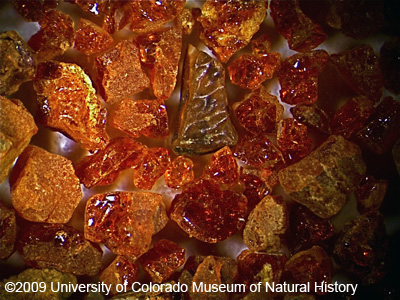

 |
 |
These tiny pieces of amber were collected by ants from the 65-70 million year old Lance Formation of Wyoming. The amber formed from the sap of conifer trees that coexisted with dinosaurs!
The Lance Formation has produced many important fossils, ranging from tiny microfossils like those collected by harvester ants to fully articulated dinosaur skeletons. It was deposited by streams on a coastal plain stretching along the shallow interior sea of the Western Interior Seaway, which cut North America in half. Dinosaurs, reptiles, fish, amphibians, birds, and small mammals, as well as the amber-producing trees, lived in a wet subtropical climate very different from today's dry seasonal climate.
Learn more about Cretaceous amber in Amber from Upper Cretaceous through Paleocene strata of the Hanna Basin, Wyoming, with evidence for source and taphonomy of fossil resins (Rocky Mountain Geology, December 2000).
Learn more about the Lance Formation with Passport-In-Time Microvertebrate Fossil Project at the University of Wyoming Geological Museum: Late Cretaceous Paleontological Resources in the Public Eye.